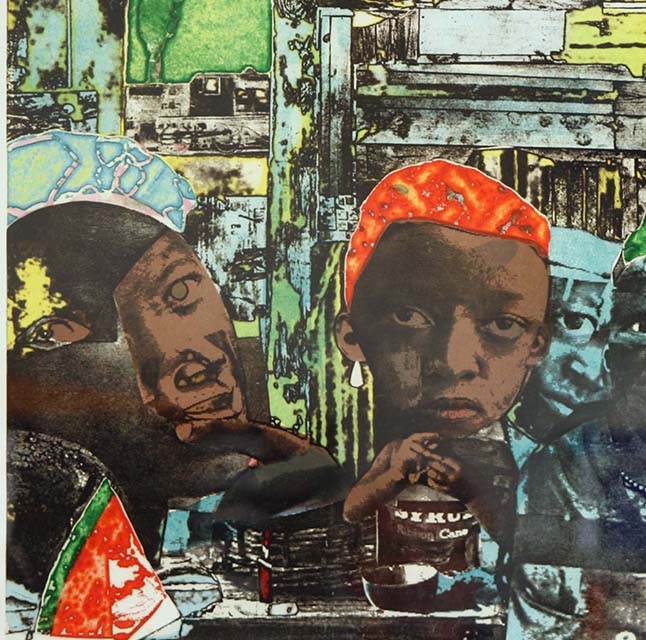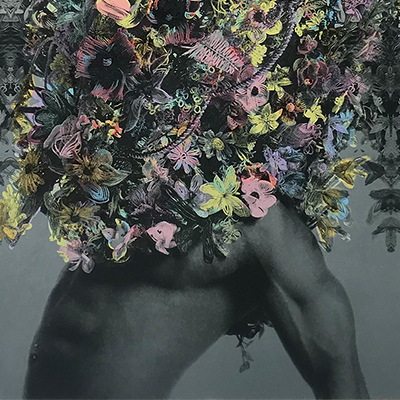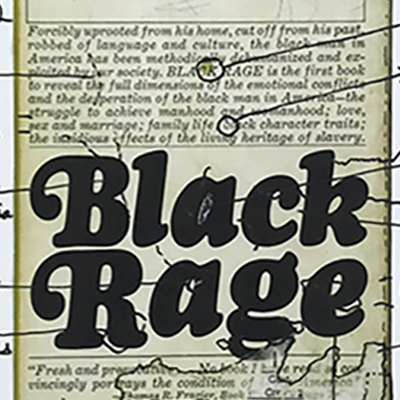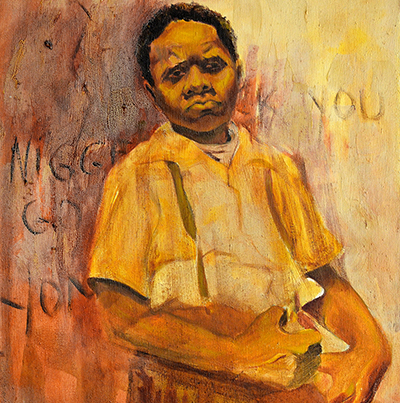iArt Featured Artists

Romare Bearden
-
The Train, 1975, etching and aquatint
| Growing up during the Harlem Renaissance of the 1920s, Romare Bearden defined “the image of man in terms of the Negro experience I know best.” His best-known works are the collages he made from 1964 on that used a fragmented style inspired by the rhythms of jazz. In The Train Bearden has cut and pasted photographs of women and of African sculpture which he reworks into black faces. The train of the prints title is a small detail that invokes larger issues of migration and segregation. Trains held great meaning for Bearden. Born in Charlotte, NC, he had a nomadic childhood as he lived at various times with his parents and grandparents in Harlem, Pittsburgh and North Carolina. According to Bearden, “I use the train as a symbol of the other civilization—the white civilization and its encroachment upon the lives of blacks.” The Bearden family’s moves were part of the Great Migration that brought millions of Southern blacks North in search of jobs and greater personal freedom. But, as Bearden implies, this movement was necessitated by circumstances created by whites. The fragmentation of the women’s forms and their shifting placement suggest their repeated dislocation.

Nick Cave
-
Head Dressed, 2019, lithograph
| The upper torso of a black male body arches backwards under the weight of an elaborate and colorful headress that sits upon the shoulders of the figurer and obscures the head. Nick Cave works between the visual and performing arts through a wide range of mediums including sculpture, installation, video, sound and performance. Cave is well known for his Soundsuits, sculptural forms that are based on the scale of his body. Soundsuits camouflage the body, masking and creating a second skin that conceals race, gender, and class, forcing the viewer to look without judgment.

Glenn Ligon
-
Black Rage, 2019, print
| Through his work, Glenn Ligon pursues an incisive exploration of American history, literature, and society across a body of work that builds on the legacies of modern painting and more recent conceptual art. He is best known for his text-based paintings which draw on the writings and speech of diverse figures including Jean Genet, Zora Neale Hurston, Gertrude Stein and Richard Pryor. This print dissects the back cover of the landmark book "Black Rage" (1968), that examines anger experienced by African-Americans in the face of persistent racism. Cracks, smudges, scribbles and yellowed tape are mapped out by a conservator, indicating the various flaws found due to age and wear.

Gordon Parks
-
Husband and Wife, Sunday Morning, Detroit, Michigan, 1950, gelatin silver print
| In 1950, photojournalist, Gordon Parks was working for Life magazine to do a story about school segregation represented by ordinary African Americans. Life agreed, and after an absence of 23 years Parks returned to the place he grew up to photograph eleven former classmates from the all-black school he once attended. Fort Scott, Kansas remained much the same but most of his classmates had been caught up in the Great Migration, leaving their small rural community for the opportunities offered by cities across the mid-west. Parks was able to locate and photograph all but two of his former classmates finding them in Kansas City, St. Louis, and Chicago. In Detroit, he found classmate, Pauline Terry, who had married Bert Collins. In their conversations she emphasized the importance of the church in their lives. The portrait has the couple looking intently into the camera lens, and is captured as they walk to Sunday services at the Macedonia Baptist Church. In Husband and Wife, the couple are framed squarely by the neighborhood where the live and there is no question that this is their community and where they belong.

Lonnie Powell
- ...Go Home, 1968, acrylic on canvas| Although the text embedded in the image is partially obscured by the body of the African American youth, the message is unequivocal and the violence it communicates is visceral. Painted in 1968, the painting portrays the experiences of African Americans throughout the country during the era when racial segregation was the pervasive rule of Jim Crow. Following the Brown v Board of Education Supreme Court decision in 1955, artist Lonnie Powell was in the first class to integrate Central High School in Kansas City. According to Powell, black students were forced to endure both verbal and physical assaults: “Going to school for the first year was like going to war.”
